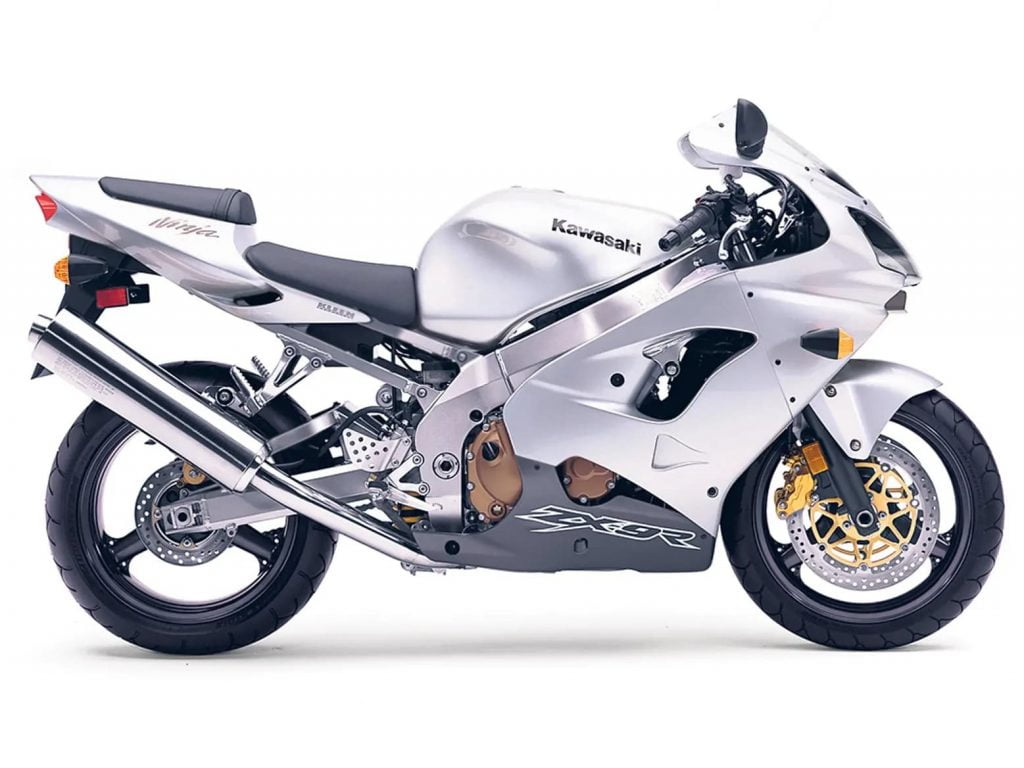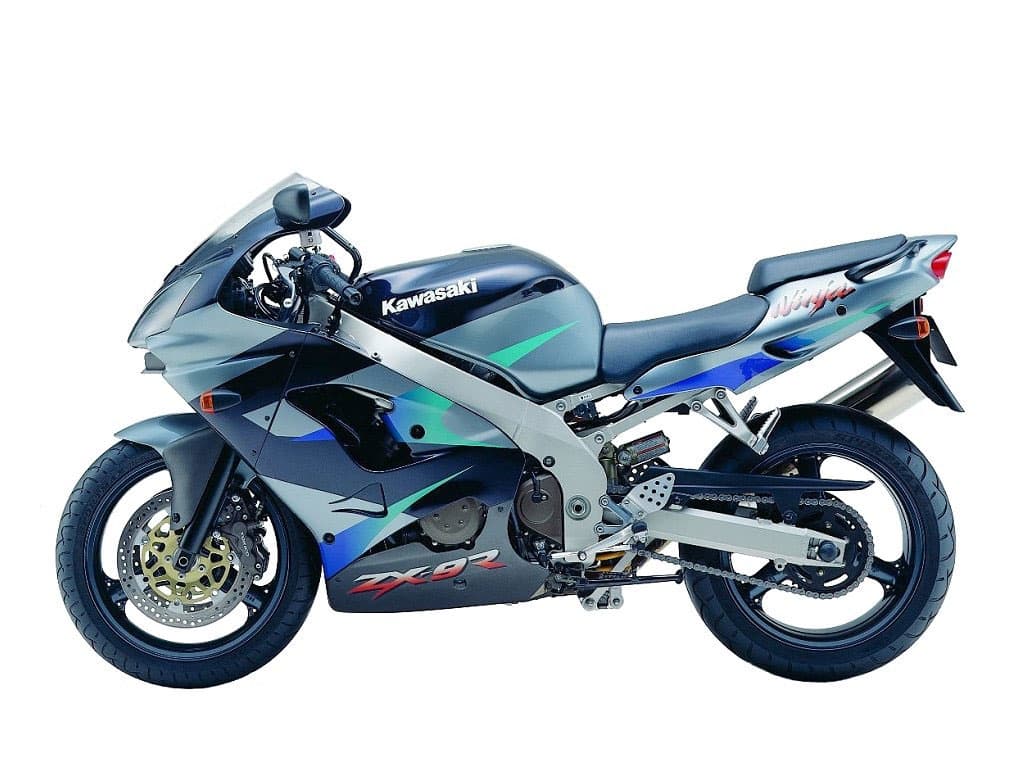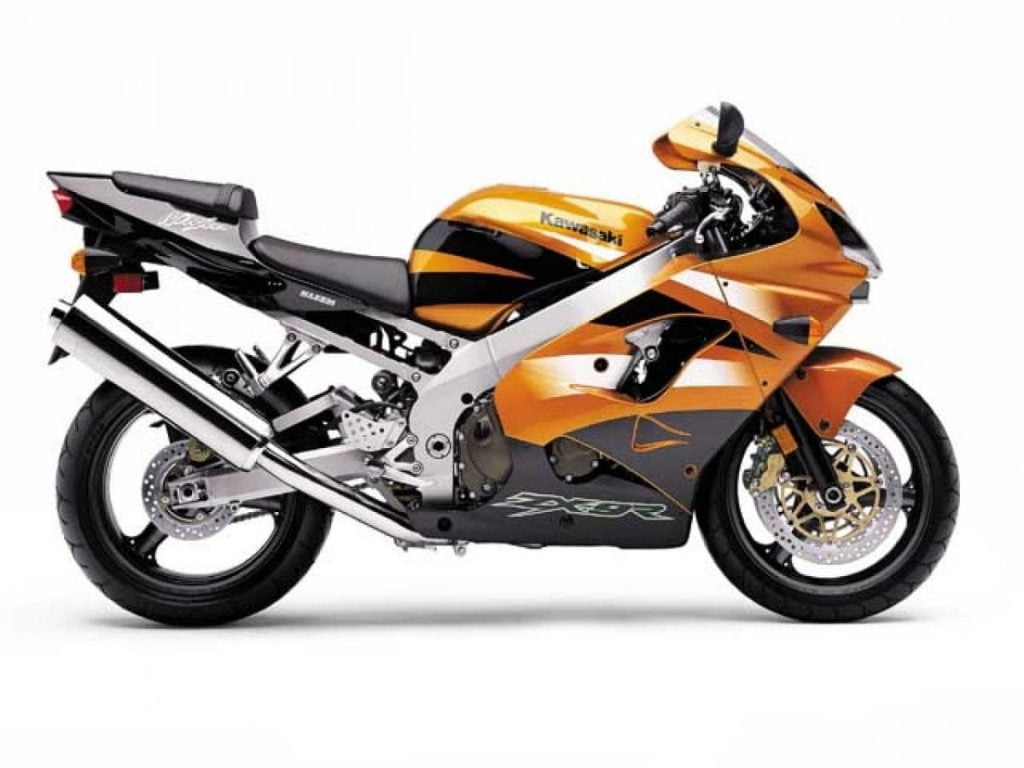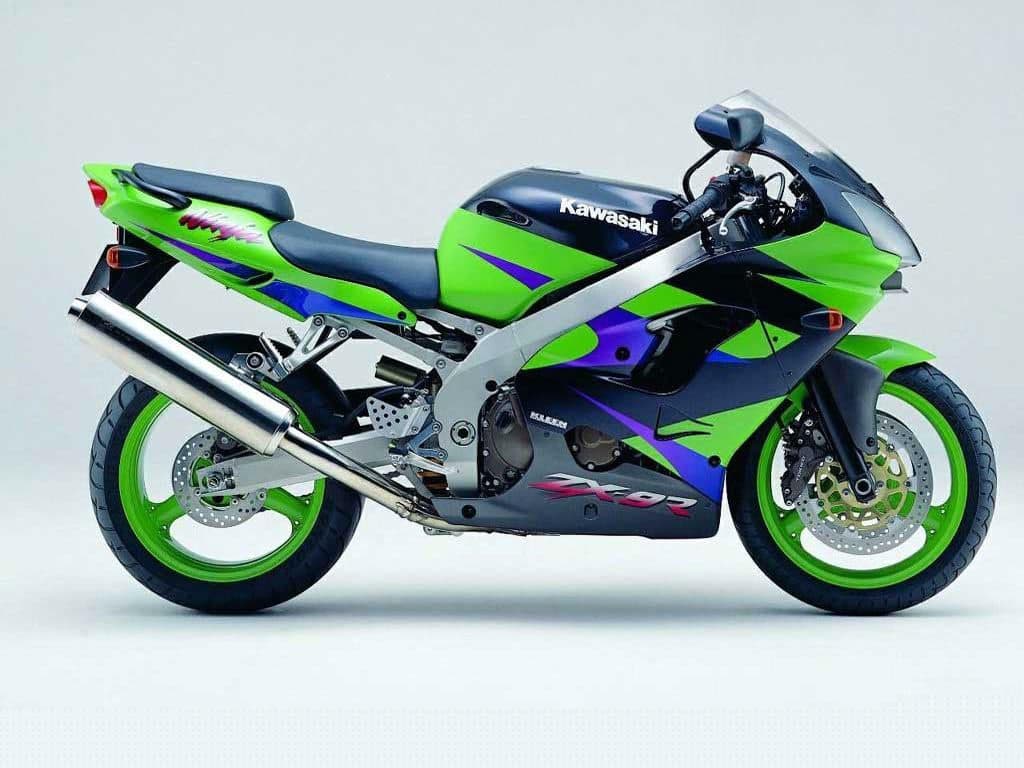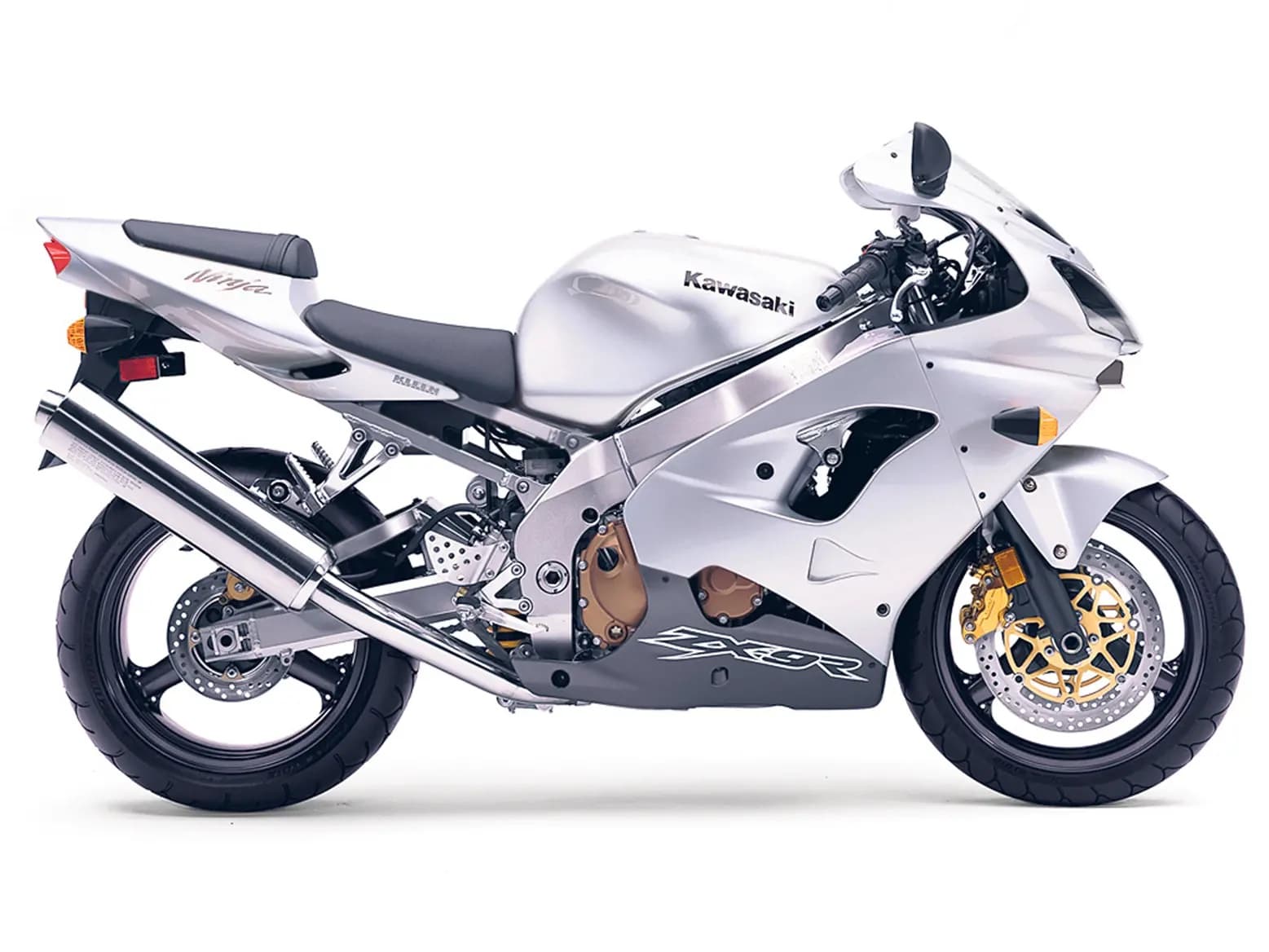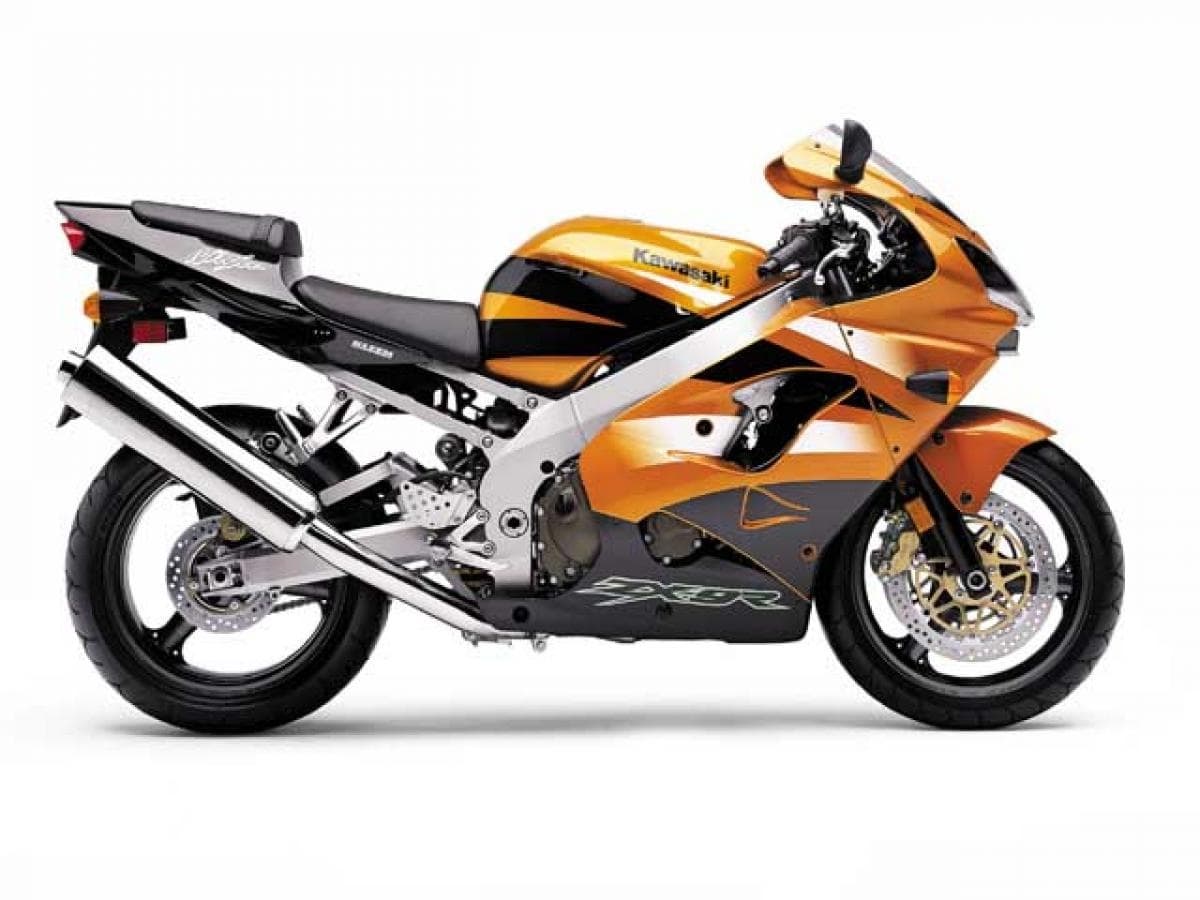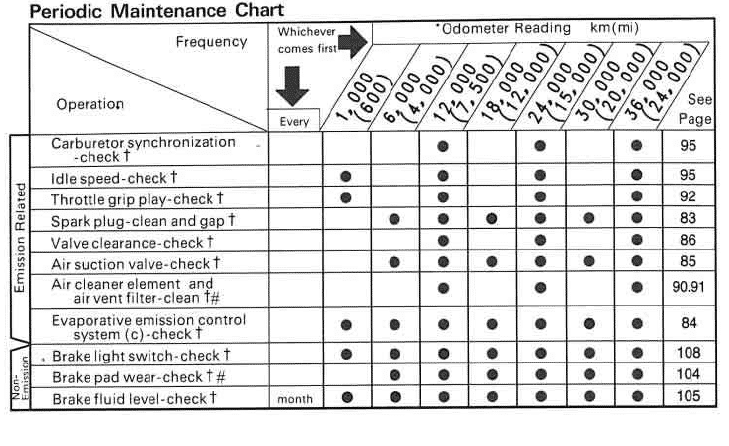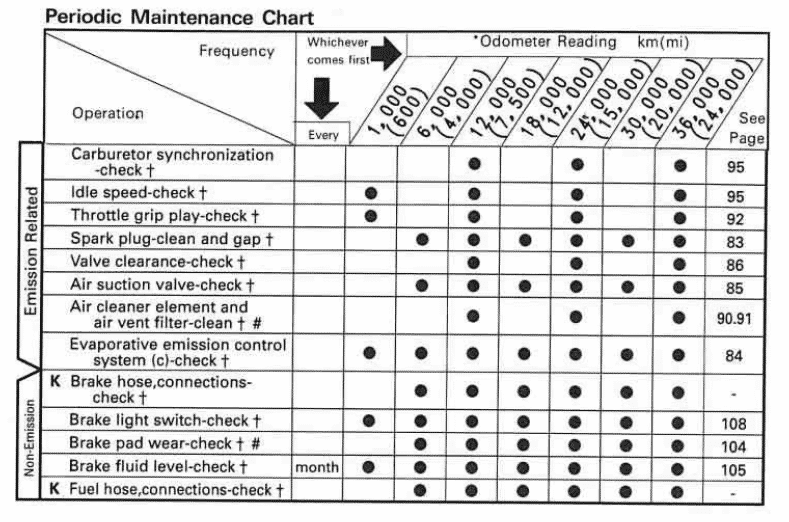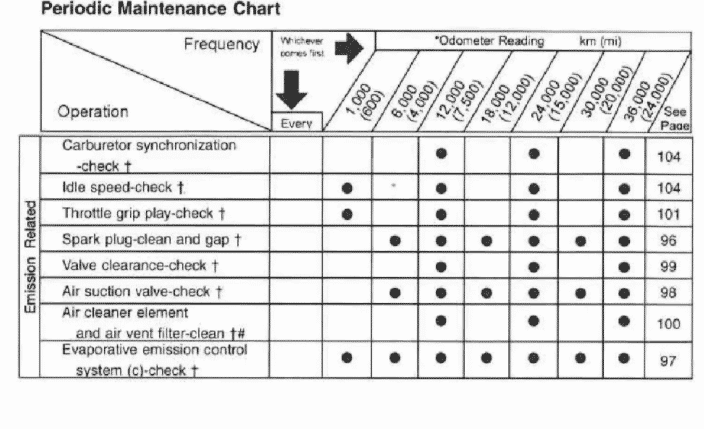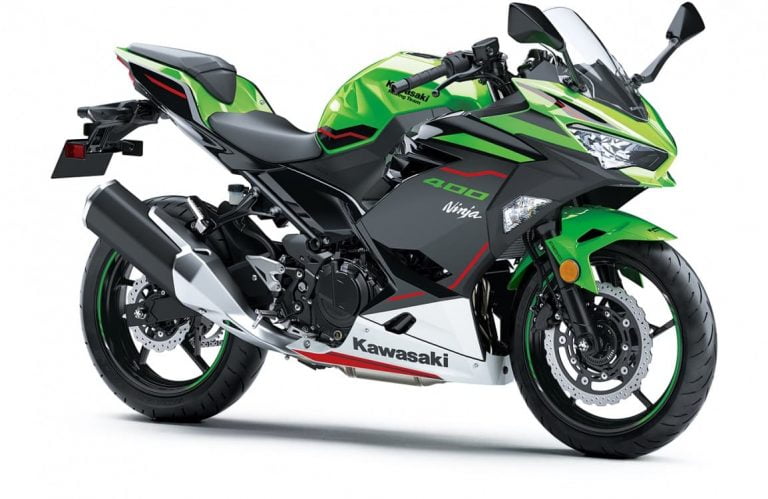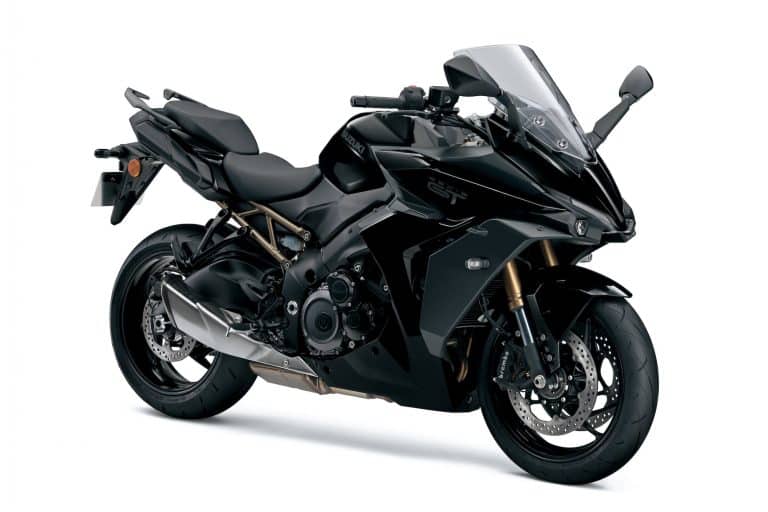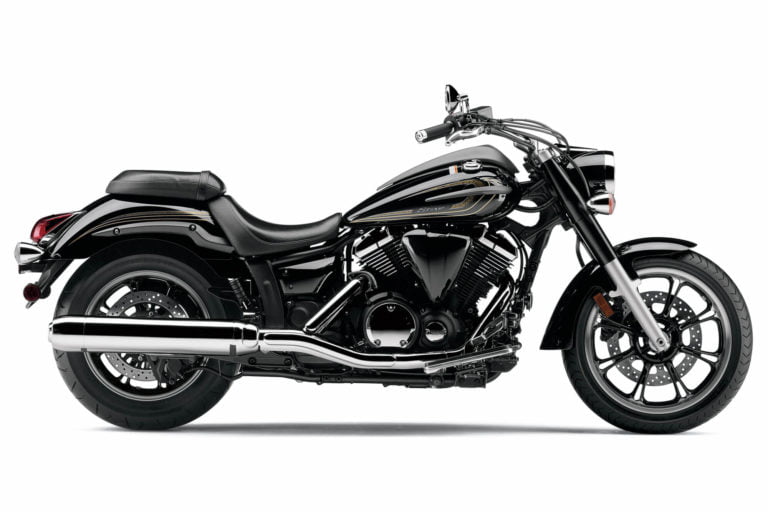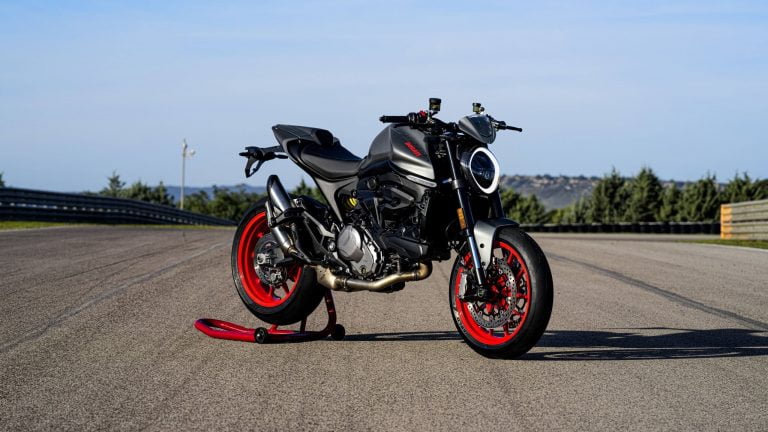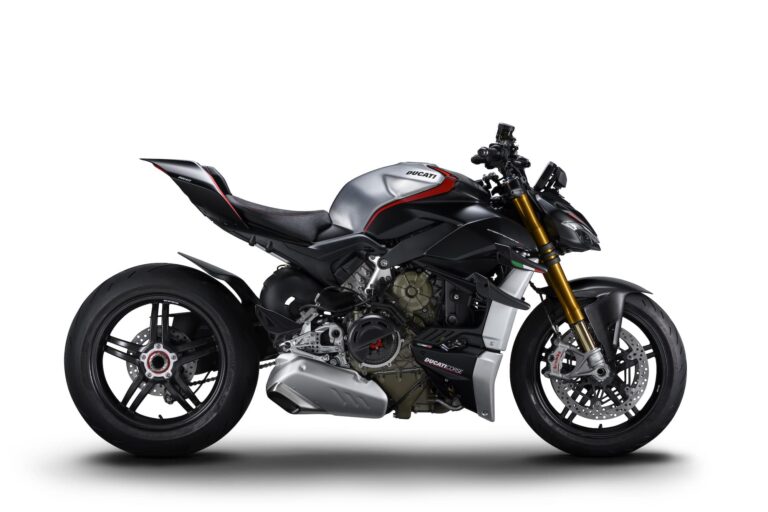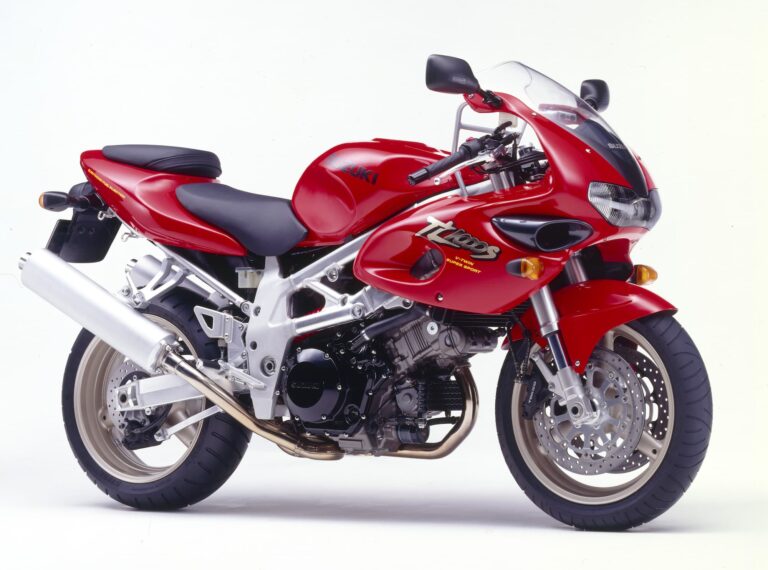Kawasaki Ninja ZX-9R (1998-2003, C/E/F models) Simplified Maintenance Schedule
This is the maintenance schedule with associated service intervals for the Kawasaki Ninja ZX-9R made between 1998 and 2003, an update on the earlier 1994-1997 Kawasaki Ninja ZX-9R.
Note: we previously had all this on one page, but have since separated out the maintenance schedules between two major generations.
The Kawasaki Ninja ZX-9R is a sport bike intended for on-road riding and track use. Kawasaki produced the ZX-9R from 1994 until 2003.
There were two major generations of engine and chassis for the ZX-9R. And during those generations, Kawasaki made some small changes to the suspension and braking.
The two generations were:
- Series 1 Kawasaki ZX-9R (1994-1997, B1-B4): The original heavier Kawasaki Ninja ZX-9R, with a slightly longer piston stroke, and a wet weight of around 240 kg / 530 lbs. This series has an upside-down fork and a hydraulic clutch. Service intervals are every 5000 mi / 8000 km.
- Series 2 Kawasaki Ninja ZX-9R (1998-2003, C1/2, E1/2, F1/2): The second Kawasaki Ninja ZX-9R motor, with a shorter piston stroke, and a frame that was much lighter for a combined wet weight of around 210 kg / 460 lb. This series has right-way-up 46mm KYB forks and a cable-operated clutch. Service intervals are every 6000 mi / 12000 km.
In 2004, the Kawasaki Ninja ZX-9R was replaced with the 1st gen Kawasaki ZX-10R, with a bigger engine and a host of other improvements.
This site has links for things like oil and spark plugs from which we earn a commission (which unfortunately nobody can save, not even us). If you appreciate this work, then please use those links. Thanks!
Overall Service Intervals for the Kawasaki ZX-9R
Overall, the Kawasaki ZX-9R (2nd gen, C/E/F models, made from 1998-2003) has 4000 mile or 6000 km service intervals.
At every service, change the oil and filter. Kawasaki recommends changing the oil every 6 months as well, but with modern oils you’re likely to get away with doing it annually if you don’t do much mileage.
Check the spark plug at every service. Every two services (8000 mile / 12000 km) do a major service, including checking the valve clearances, doing a carb sync, and doing a bunch of other checks.
Also, change the brake fluid on schedule. The 1998-2003 has a cable-operated clutch, so at least there’s one less fluid to change. But keep that cable lubricated!
What you need to service the Kawasaki Ninja ZX-9R
Below is a list of general parts / items you need to service your Kawasaki Ninja ZX-9R.
| Part | Kawasaki ZX-9R Spec |
|---|---|
| Oil | You need 3.3L (3.5 qt) of SAE 10W-40 engine oil “with API SE, SF, SG, SH, SJ, with JASO MA rating”, preferably Kawasaki 10W-40 Engine Oil. Don’t over-torque the drain bolt (spec is 20 Nm/15 lb-ft per the manual) — use a torque wrench if you don’t have experience with how much torque is enough. |
| Oil filter | Oil filter is part 16097-0008, or you can use an HF303. Torque for oil filter is 10 Nm (7 ft-lb) (use a torque wrench, and it’s easier on the HifloFiltro one) |
| Front brake pads | For the front brake pads, an easy upgrade is double-hardened EBC brake pads, which give great bite and fade resistance. Pay attention to which model you have, as the brakes changed. * C1-C2, E1-E2 (six-piston Tokico calipers): FA188HH * F1-F2 (four-piston Nissin calipers): FA347HH |
| Rear brake pads | For the rear brake pads, a good-quality and easy-to-obtain option is EBC FA192HH (for all model years). |
| Spark plugs | NGK CR9EK, with a spark plug gap of 0.7-0.8mm (use a spark plug gapping tool), torqued to 13 Nm or 9.4 ft-lb (use a torque wrench) |
| Air filter | These days it’s easier to get K&N replacements. Parts: KA-9098, OEM 11013-1270 |
| Cable lubricant | Remember to lubricate your clutch cable and throttle cable with a cable lubricant. Protect All Cable Life is a good general-purpose lubricant. |
| Chain lubricant | The chain needs to be lubricated every 600 km/ 400 miles (or more, if it gets wet/dirty). Motul chain paste is cheap and well-loved. |
| Brake fluid | Spec is to use DOT-4 brake fluid, e.g. Castrol DOT 4. The 1998+ model has a clutch cable so you don’t need to change clutch fluid. |
| Coolant | Use “green” 50/50 ethylene glycol-based coolant with anti-corrosion inhibitors, e.g. Valvoline Zerex G05. |
| Grease | Use a lithium soap based grease for all the important greasing points. |
Maintenance Schedule for Kawasaki Ninja ZX-9R
Below is the maintenance schedule for the Kawasaki Ninja ZX-9R.
Because the original maintenance schedule is a bit chaotic, we’re separated out the schedule into two sections — periodic maintenance, with all the important items, plus the general inspection checklist of things to look over at every inspection.
Periodic maintenance table
The following is the list of maintenance operations and to be done on this motorcycle with a time or distance interval — whichever comes earlier.
Notes:
- For higher odometer readings, repeat at the frequency interval established here (every 4000 miles / 6000 km, or 6-12 months)
- For items marked “check” — adjust, torque, or replace as necessary
- I’ve revised the mileage intervals slightly as they were erratic, and it makes easier sense to think of it as 4000 mile / 6000 km service intervals.
| mi x 1000 | 4 | 8 | 12 | 16 | 20 | 24 | |
|---|---|---|---|---|---|---|---|
| km x 1000 | 6 | 12 | 18 | 24 | 30 | 36 | Every |
| Perform general inspection checklist (see below) | ✓ | ✓ | ✓ | ✓ | ✓ | ✓ | |
| Engine oil — change (Kawasaki 10W-40 Engine Oil) | ✓ | ✓ | ✓ | ✓ | ✓ | ✓ | 6 months (See notes above on service intervals) |
| Engine oil filter — change (HF303) | ✓ | ✓ | ✓ | ✓ | ✓ | ✓ | |
| Spark plug — check, clean and gap, replace as necessary — NGK CR9EK | ✓ | ✓ | ✓ | ✓ | ✓ | ✓ | |
| Valve clearances — check, adjust | ✓ | ✓ | ✓ | ||||
| Air cleaner element and air vent filter — clean, replace as necessary (KA-9098) | ✓ | ✓ | ✓ | More often if riding in wet / dusty conditions | |||
| Carburetor synchronization — check | ✓ | ✓ | ✓ | ||||
| Idle speed — check | ✓ | ✓ | ✓ | ||||
| Throttle grip play — check | ✓ | ✓ | ✓ | ||||
| Brake fluid — change (Castrol DOT 4) | ✓ | 2 years | |||||
| Brake master cylinder cup and dust seal — replace | 4 years | ||||||
| Brake caliper piston seal and dust seal — replace | 4 years | ||||||
| Nuts, bolts, and fasteners tightness — check torques / condition | ✓ | ✓ | ✓ | ||||
| General Lubrication — perform * External pivot points and controls: Lithium soap-based grease * Cables: Protect all cable life | ✓ | ✓ | ✓ | ||||
| Front fork — check for leaks, smooth operation | ✓ | ✓ | ✓ | ||||
| Front fork oil — change | ✓ | 2 years | |||||
| Rear shock absorber — check for leaks, smooth operation | ✓ | ✓ | ✓ | ||||
| Swingarm pivot, uni-trak linkage — lubricate | ✓ | ✓ | ✓ | ||||
| Coolant — change | ✓ | 2 years | |||||
| Steering stem bearing — check, lubricate | ✓ |
Kawasaki Ninja ZX-9R Basic service checklist
Below is the basic inspection checklist to do on your ZX-9R at every service.
| Kawasaki ZX-9R — Basic service checklist |
|---|
| Brake hose connections — check for wear / leaks |
| Brake light switch — check |
| Brake pad wear— check thickness |
| Brake fluid level — check, top up as necessary (fluid level drops as brake pads wear out) |
| Fuel hose, connections — check for leaks and wear |
| Clutch — check for slip and for free play, adjust as necessary |
| Steering — check for smooth operation |
| Drive chain wear — check See below for more notes ondrive chain wear |
| Tire wear — check |
| Radiator hoses, connections — check condition, and for leaks |
| Evaporative emission control system (if fitted) — check |
| Air suction valve — check |
Maintaining Your Chain on the Kawasaki ZX-9R
It’s important to maintain your chain on the Kawasaki Ninja ZX-9R, as on any chain-driven motorcycle, but especially on one you’re likely to flog hard!
Use a good-quality chain lubricant like Motul chain paste, or a Motul chain care kit which comes with a couple of handy tools to maintain the chain.
Kawasaki recommends you follow the following chain maintenance schedule:
| Chain maintenance item | Every |
|---|---|
| Check drive chain lubrication condition, lubricating if necessary (Motul chain paste) | 400 mi / 600 km |
| Check drive chain slack, adjusting if necessary | 600 mi / 1000 km |
| Check drive chain wear. If replacing, also replace sprockets. | 4000 mi / 6000 km (service) |
Notes:
- Do these items (checking/adjusting slack, and checking/applying lubrication) more often if you ride your ZX-9R in dusty or rainy conditions.
- Always lubricate the chain after washing the motorcycle.
Tire size and pressure for the Kawasaki Ninja ZX-9R
The Kawasaki Ninja ZX-9R has the following tire sizes standard, and the following recommended tire pressures:
| Tyre | Size | Tyre pressure |
|---|---|---|
| Front | 120/60 ZR17 (58W) 120/70 ZR17 M/C (58W) | 250 kPa / 36 psi |
| Rear | 190/50 ZR17 M/C (73W) | 290 kPa / 42 psi |
The ZX-9R originally shipped with Michelin Radial Pilot Sport, Bridgestone BT012, or Dunlop D208 tires.
About the Kawasaki Ninja ZX-9R (1998-2003, C/E/F models)
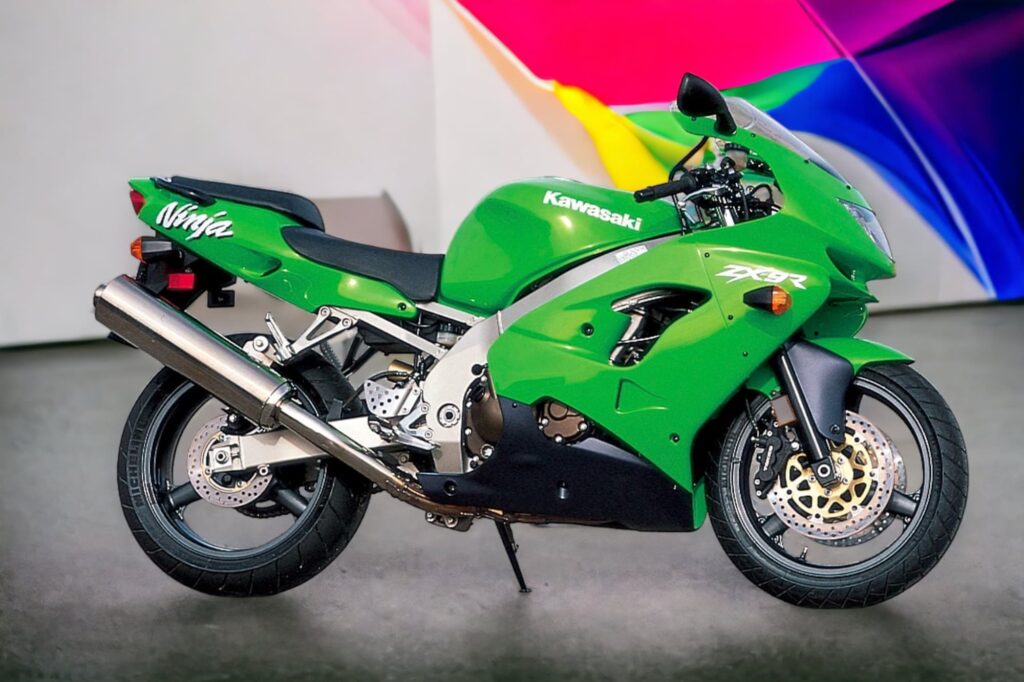
The Kawasaki ZX-9R was Kawasaki’s answer to the CBR900RR — creating bikes as lightweight as the 750cc class but with the power of the 1000cc class (well, nearly).
The ZX-9R has an 899 cc, transverse four-cylinder, four-stroke engine, fed by carburettors through its whole lifetime. The frame used on the ZX-9R is a lightweight aluminum twin-spar item.
The ZX-9R got a host of upgrades during its lifetime, but the most significant change was in 1998, when Kawasaki gave it a new motor. It was still 899 cc in capacity, but more free-revvign with a shorter stroke engine.
At the same time, Kawasaki made many changes to the chassis, suspension, and even engine to reduce weight and bring it within shooting distance of the competition. Alas, they couldn’t keep up with bikes like the 1998 Yamaha YZF-R1, but at least it wasn’t as embarrassingly porky as the original 1994-1997 Kawasaki Ninja ZX-9R.
Common specs to all Kawasaki Ninja ZX-9R models:
- The engine in the ZX-9R always had a displacement of 899 cc, though the bore and stroke did change.
- The forks and shock were always fully adjustable, though there was a spec change in upside down vs right way up in 1998.
- Power was always roughty the same — around 105 kW or 140 hp. The quoted power did change slightly (see below) but it’s more likely that other conditions (e.g. tuning, current condition) will have more significant impact on power.
| ZX-9R Year | 1994-1995 | 1996-1997 | 1998-1999 | 2000-2001 | 2002-2003 |
|---|---|---|---|---|---|
| Model designation | B1/B2 | B3/B4 | C1/C2 | E1/E2 | F1/F2 |
| Peak power | 104 kW / 139 bhp @ 10500 rpm (Restricted in some markets) | 105 kW / 141 bhp @ 10500 rpm | 107 kW / 143 hp @ 11000 rpm | 105 kW / 144 hp @ 11000 rpm. Dyno: 131 hp @ 10500 rpm | 105 kW / 144 hp @ 11000 rpm. |
| Peak torque | 94 Nm / 69 ft-lb @ 9000 rpm | 94 Nm / 69 lb-ft @ 9000 rpm | 101 Nm / 74 lb-ft @ 9000 rpm | 101 Nm / 74 ft-lb @ 9000 rpm | 101 Nm / 74 ft-lb @ 9000 rpm |
| Bore / stroke (mm) | 73 x 53.7 | 73 x 53.7 | 75 x 50.9 | 75 x 50.9 | 75 x 50.9 |
| Compression ratio | 11.5:1 | 11.5:1 | 11.5:1 | 12.2:1 | 12.2:1 |
| Cam design | Rocker arm | Rocker arm | Shim-under-bucket | Shim-under-bucket | Shim-under-bucket |
| Clutch design | Hydraulic | Hydraulic | Cable | Cable | Cable |
| Front suspension | KYB 41mm inverted forks | KYB 41mm inverted forks | 46mm conventional cartridge fork | 46mm conventional cartridge fork | 46mm conventional cartridge fork |
| Rear suspension | KYB damper, remote reservoir | KYB damper, remote reservoir | Uni-trak, monoshock | Uni-trak, also adjustable for ride height | Uni-trak, also adjustable for ride height |
| Front brakes | 2 x 310 mm discs, Four-piston Tokico | 2 x 310 mm discs, Six-piston Tokico | 2 x 310 mm discs, Six-piston Tokico | 2 x 310 mm discs, Six-piston Tokico | 2 x 320 mm discs, Nissin four-piston caliper |
| Wet weight See note | ~235 kg / 518 lb | 242 kg / 533 lb | 205 kg / 452 lb | 211 kg / 466 lb | 471 lb |
Note on weight: these are from multiple sources and are likely off by ~5%, especially as people modify their bikes. The most notable change is the 60-80 lb weight drop for the 1998 model ZX-9R, bringing it into competitive earshot of the competition.
The first generation 1994-1997 ZX-9R was the one that defined it. It has an 899 cc liquid-cooled four-cylinder engine that’s thoroughly modern, with dual overhead camshafts and four valves per cylinder. It breathes through four carbs (that have to be kept in sync!) and makes enough power, near the maximum of a power/weight ratio before you need rider aids to keep you in check.
But the original series of Kawasaki Ninja ZX-9R was heavy — weighing around 235 kg or 520 lbs, give or take. This is very heavy for a sportbike, which most riders expect to weigh around 200 kg / 440 lb, even back then. This power:weight ratio makes it more like a modern Kawasaki Ninja 1000. Not slow, but not razor sharp.
The second gen Kawasaki Ninja ZX-9R is a different story. Kawasaki saw the errors of their ways and made a much lighter bike with a free-er revving, shorter stroke engine.
To do this, Kawasaki
- Changed the frame to a shorter aluminium twin-spar without downtubes, using the engine as a stressed member
- Changed the front suspension from 41 mm inverted forks to 46 mm conventional forks — an interesting move, with most motorcycles going in the opposite direction!
- Change the rear swingarm / suspension
- Installed Plug-mounted coils, rather than high-tension leads
- Made internal revisions to the engine, including getting rid of things like the counterbalancer, saving weight but adding a bit of vibration (which is also known as “character”), and deleting the back torque eliminator from the clutch
The Kawasaki Ninja ZX-9R series isn’t as well regarded as the other sportbikes of the era, the Honda CBR900RR FireBlade and the class-redefining Yamaha YZF-R1.
But what makes the ZX-9R unique is that it’s actually a competent streetbike. The R1 is a fire-breathing monster. The CBR900RR is a great streetbike too, but the ZX-9R is even more street-oriented — without balls-to-the-wall outright power, nor the lowest weight, but a comfortable riding position and decent weather protection.
On top of that, as an underdog, it’s cheaper to buy than its competition — if you can find one.
Manual for the Kawasaki Ninja ZX-9R
The above maintenance schedule comes directly from the user’s manual for the Kawasaki Ninja ZX-9R. See below for screenshots.
We checked back to the 1998 manual to confirm the maintenance elements were the same.
You can access the manuals from Kawasaki’s website here, referring to digitised versions of old manuals.
